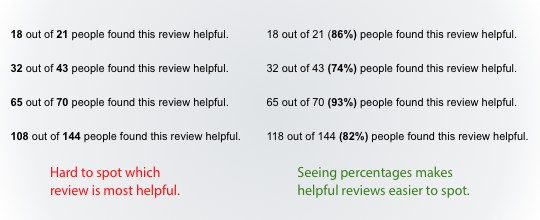Buying products online is never a sure thing. That’s why most users will read the reviews of a product before they buy it. However, the amount of reviews for a product can get quite large over time. It’s time-consuming for users to read every single review. It’s more efficient for them read the most helpful ones and ignore the unhelpful ones. To solve this problem, most eCommerce sites have a feature that allows users to vote whether a review was helpful or not after they have read it. The votes are tallied and displayed on each review so that users can spot the helpful ones. As useful as this feature is, the way sites display these user votes needs improvement.

Instead of just showing how many users out of the total number of voters found a review helpful, show the percentage of users who found a review helpful. This makes the helpful reviews easier to spot. Instead of reading every review, users can sift through the unhelpful reviews and read the most helpful reviews to get better information and save time. It’s difficult for users to calculate how helpful one review is over another when the votes are written in fraction form. Displaying them in a percentage form allows users to effectively scan and weigh each review before they invest time in reading it.
Not every review is equally helpful. Users won’t know which ones they should spend their time reading if a voting percentage isn’t displayed. This technique is useful for large eCommerce sites that get a lot of product reviews such as Amazon and eBay. If you want to give your users a good product review experience, don’t force them to read every review, and don’t make them think. Make helpful reviews easy to see by not just showing the number of helpful votes, but also the percentage of helpful votes. By doing this you’ll speed up the user’s research efforts and save them time.


Seem quite not enough, I think…
How about the total number ? A post with 90% of 10.000 peoples and a post with 97% of 200 peoples… Is it easy to say the second one is more helpful ?
I saw on Youtube and many other sites – They ‘re good when represent the like/dislike ratio by a green/red bar, then note the number of voting peoples below that bar… Was it also a good solution ^^ ?
@Obelisk: I once found an interesting article/method for your case: http://www.evanmiller.org/how-not-to-sort-by-average-rating.html